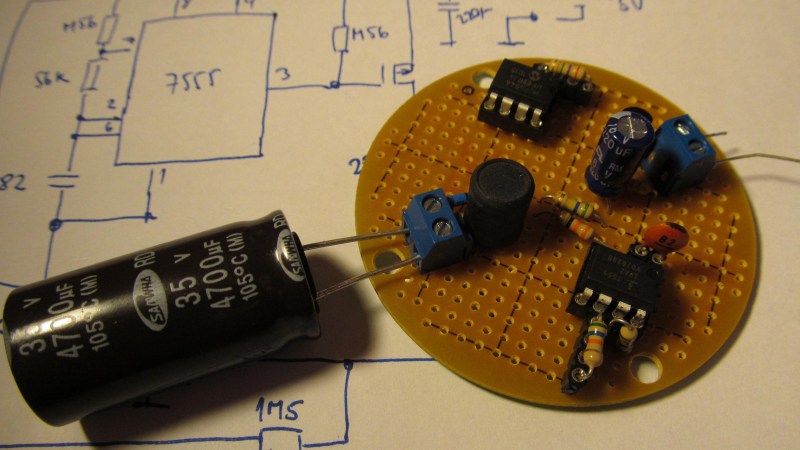Welding equipment is always expensive and bulky, right? Heavens no! [Jaromir Sukuba] is making a welder for battery tabs which can fit in a pocket and gets its power from a coin cell. It may be expensive to power compared to a mains welder, but for the sake of portability this is quite the hack. Not only that, but it uses 555 timers in the charging circuit.

His entry for the 2017 Coin Cell Challenge saps every bit of power from a coin cell and stores it up in a 100F supercapacitor bank. All that stored energy takes a long time to get into the supercapacitors but it comes out in a flash. In fact, it can take 12 hours to fully charge. For the convenience of size, we have to trade the convenience of speed. This should be a strong contestant for the Supernova and Heavy Lifting categories.
We see a quick demonstration of a successfully welded tab which shows that using coin cells to weld metal to coin cells is equally ironic and apropos. Other welders on Hackaday feature a quicker way to control your battery tab welding, safety-rich spot welding, or just go off the rails completely and use an arc welder to make a coil gun.
















Not sure how practical it might be, but there’s .109g of lithium in a CR2032. Li+H2O –> Li2O + H2 (kinda). Looks like heat is something on the order of 500kJ/mol. Given there’s 6.941 g/mol, I think you should be able to get 7kJ of heat out of single CR2032 battery relatively quickly. I could set up a thermal model to see if you can weld, but this might be a quicker approach to welding.
… via charging a supercap.
I hope the supercap is rated for pulse discharge. I am 99% sure that it is not. I doubt with the energy involved you will get a violent explosion but I suspect you will quickly damage the cap.
Though not specifically designed for pulse power applications, the capacitors I used do have specified short circuit current. They suffered a lot in my hands, yet their capacity nor self-discharge current doesn’t seem to be affected, so they are quite OK with what I’m doing to them.
That being said, I was aware that those cheap, locally available capacitors are not the best ones for the job. Last week I ordered a pair of 100F DGH-series low ESR supercaps from Illinois capacitors, designed for pulse/fast discharge. I hope those will be delivered until Christmas.
Suppose no big surprise here, but seems like a lot of people are basing their coin cell project around the idea of charging a capacitor over a 12 – 24 hour period.
I assume the judges won’t be taking any points off for time required to perform the device’s intended function…
4800 ųF cap. Charge it. Put strip on coin cell. Keep fingers clear. Overt eyes. Touch cap to weld.
Photo flash cap or a decent electrolytic. No point in slow release.
That’s a way of rendering µ that I haven’t seen before. I guess it makes a sort of sense if you have an ogonek mapped on your keyboard?